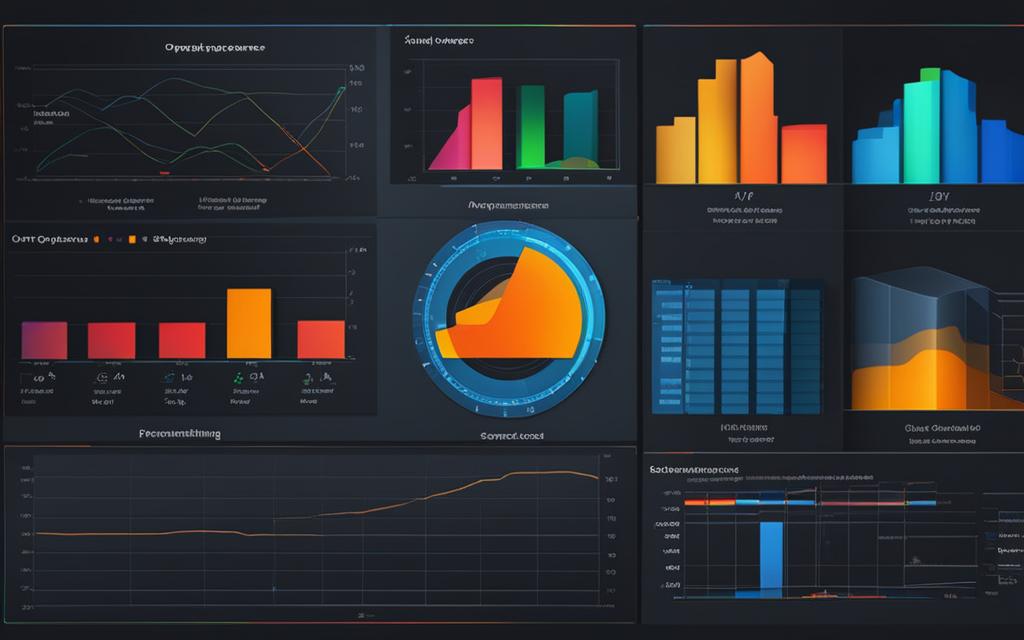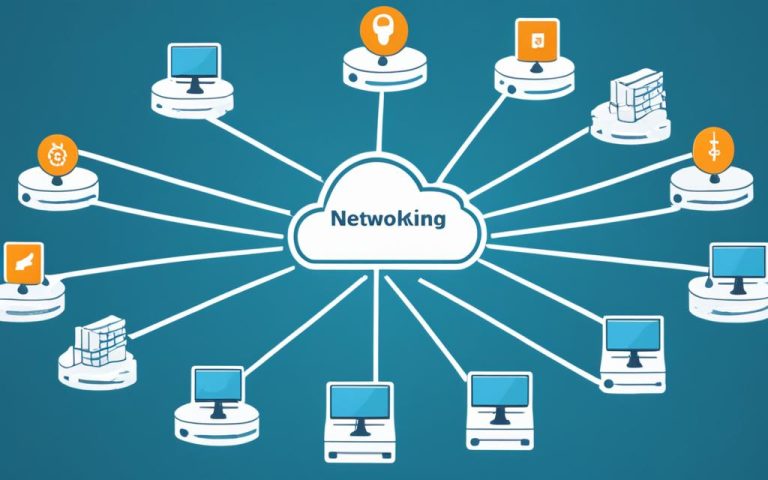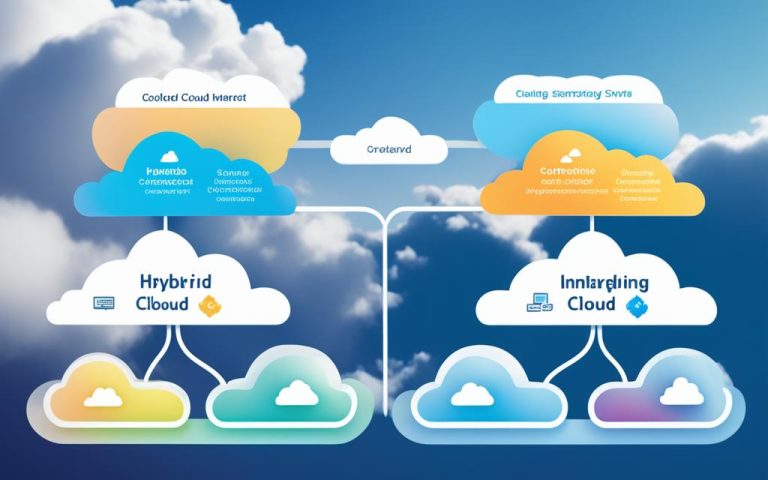Cloud-based operating systems (OS) have revolutionized the way businesses manage their IT infrastructure. With the rise of cloud computing, efficient management of operating systems in cloud networks has become vital to optimize uptime and performance.
Cloud monitoring tools provide the means to review, observe, and manage the operational workflow in a cloud-based IT infrastructure. It involves monitoring the availability and performance of websites, servers, applications, and other components of the cloud infrastructure.
There are different types of cloud monitoring, including database monitoring, website monitoring, virtual network monitoring, cloud storage monitoring, and virtual machine monitoring. Each type focuses on specific aspects of the cloud environment to ensure efficient operations and address potential issues.
Cloud monitoring offers several benefits for businesses. It allows seamless scalability, enabling organizations to handle increased activity without disruptions. With dedicated tools provided by the host, businesses can maintain efficient monitoring processes across various devices and locations.
Installing and using cloud monitoring tools is simple and cost-effective. These tools provide real-time insights into the performance and availability of cloud-based resources, enabling businesses to identify and address minor issues before they escalate into major problems.
Types of Cloud Monitoring
In cloud computing, various types of monitoring techniques are employed to ensure the optimal performance and availability of cloud-based resources. Here, we explore the main types of cloud monitoring, including database monitoring, website monitoring, virtual network monitoring, cloud storage monitoring, and virtual machine monitoring.
1. Database Monitoring
Database monitoring involves analyzing and managing database processes, queries, availability, and resource consumption. By monitoring databases, organizations can ensure efficient utilization of resources, improved query execution, and timely identification of potential issues.
2. Website Monitoring
Website monitoring focuses on tracking processes, web traffic, availability, and resource utilization of cloud-hosted websites. It helps organizations identify and address performance bottlenecks, ensure seamless website access, and enhance the overall user experience.
3. Virtual Network Monitoring
Virtual network monitoring involves creating software-based replicas of network technologies to optimize traffic flow within a cloud environment. By monitoring virtual networks, organizations can effectively manage network performance, detect and troubleshoot connectivity issues, and enhance network security.
4. Cloud Storage Monitoring
Cloud storage monitoring pertains to tracking and analyzing analytics, performance metrics, processes, and available storage in cloud-based storage systems. It enables organizations to optimize storage utilization, ensure data reliability and durability, and identify trends and usage patterns for efficient resource planning.
5. Virtual Machine Monitoring
Virtual machine monitoring focuses on monitoring the uptime, CPU utilization, and resource allocation of virtual machines within a cloud infrastructure. With virtual machine monitoring, organizations can identify performance anomalies, optimize resource allocation, and ensure the smooth operation of applications and services.
By employing these types of cloud monitoring, organizations can proactively manage and optimize their cloud infrastructure, ensuring high performance, scalability, and availability.
| Type of Cloud Monitoring | Main Focus Areas |
|---|---|
| Database Monitoring | Processes, queries, availability, resource consumption |
| Website Monitoring | Processes, web traffic, availability, resource utilization |
| Virtual Network Monitoring | Optimizing traffic flow, connectivity, network security |
| Cloud Storage Monitoring | Analytics, performance metrics, processes, storage utilization |
| Virtual Machine Monitoring | Uptime, CPU utilization, resource allocation |
By leveraging the right types of cloud monitoring, organizations can achieve enhanced performance, improved resource utilization, and proactive issue detection – contributing to the overall success of their cloud-based operations.
Benefits of Cloud Monitoring
Cloud monitoring offers a range of benefits that contribute to efficient management and optimized performance of cloud-based resources. From seamless scaling to a cost-effective subscription model, here are some key advantages:
Seamless Scaling for Increased Activity
With cloud monitoring, businesses can effortlessly scale their resources to accommodate increasing levels of activity. Whether it’s a sudden spike in website traffic or the need to handle additional data processing, cloud monitoring ensures that the infrastructure can dynamically adjust and meet the demands without compromising performance.
Maintenance of Dedicated Tools by the Host
One of the advantages of cloud monitoring is the provision of dedicated tools by the hosting provider. These tools are specifically designed for monitoring cloud-based environments, offering comprehensive insights into performance metrics, resource utilization, and system health. By outsourcing the management of monitoring tools to the host, businesses can focus on their core operations while benefitting from reliable and up-to-date monitoring capabilities.
Multi-Device Usage for Monitoring Apps from Any Location
Cloud monitoring allows users to access and monitor their applications from any device and location. Whether you’re on the go or working remotely, the ability to monitor your cloud-based resources through smartphones, tablets, and laptops ensures that you have convenient and real-time visibility into the performance and health of your systems.
Simple Installation due to Existing Infrastructure
Implementing cloud monitoring is often straightforward, thanks to the existing infrastructure and compatibility with popular cloud platforms. By leveraging the infrastructure already in place, businesses can quickly integrate monitoring tools and start monitoring their cloud resources without complex setup processes or extensive configuration requirements.
No Interruptions during Local Problems
Cloud monitoring mitigates the impact of local problems on the overall system. Even if there are issues with individual components or localized disruptions, cloud monitoring helps identify and address them before they escalate into major problems. This proactive approach minimizes downtimes, improves reliability, and ensures a smooth user experience.
Cost-Effective Subscription-Based Solutions
Cloud monitoring offers cost-effective subscription-based models, where businesses only pay for the monitoring services they require. This eliminates the need for upfront investments in hardware and software, reducing capital expenses. Additionally, subscription-based models often provide flexible plans that can be scaled up or down based on the specific monitoring needs of the business.
Overall, cloud monitoring provides extensive control, visibility, and optimized performance for public, private, and hybrid cloud environments. By leveraging the benefits of scaling, dedicated tools, multi-device usage, simple installation, no interruptions, and cost-effective solutions, businesses can ensure the availability and performance of their cloud-based resources, prevent minor issues from turning into significant problems, and streamline the monitoring and management of their cloud infrastructure.
Cloud Network Monitoring
Cloud network monitoring is a subset of network monitoring specifically designed to analyze and manage the performance of the network infrastructure within a cloud-native environment. As more businesses adopt cloud services and applications, the need for effective monitoring becomes crucial. However, cloud adoption introduces complexities to network monitoring, such as application relocations and the requirement to track performance, latency, and other metrics.
Cloud network monitoring provides valuable insights into traffic patterns, workload-awareness, and the detection of potential risks, ensuring a seamless flow within the cloud infrastructure. By closely monitoring and analyzing key metrics such as latency, throughput, packet loss, connectivity, bandwidth usage, and network uptime, businesses can identify and address any issues or bottlenecks that may impact their cloud network’s performance and availability.
In a cloud-native environment, understanding traffic patterns is essential for optimizing network performance and resource allocation. Cloud network monitoring enables businesses to gain visibility into network traffic flows, identifying potential congestion points and enabling efficient traffic management.
Workload-awareness is another crucial aspect of cloud network monitoring. By monitoring the relationship between network traffic and workload distribution, organizations can make informed decisions regarding infrastructure scaling, resource allocation, and application deployment.
“Efficient cloud network monitoring is vital for businesses embracing cloud services, as it provides valuable insights into traffic patterns, workload-awareness, and potential risks.”
Cloud network monitoring also plays a key role in risk detection and mitigation. By proactively monitoring for anomalies or security threats in network traffic, organizations can identify potential risks and take prompt action to safeguard their cloud infrastructure and data.
Advantages of Cloud Network Monitoring
Cloud network monitoring offers several advantages in a cloud-native environment:
- Real-time visibility into network traffic patterns for efficient resource allocation and traffic management
- Proactive identification and mitigation of potential risks and security threats
- Optimization of network performance through workload-awareness
- Enhanced scalability and flexibility to support dynamic cloud environments
- Improved network uptime and reliability
Cloud network monitoring is a critical component of managing and optimizing cloud-based networks. By leveraging monitoring tools and techniques tailored for cloud networks, businesses can ensure the smooth operation of their cloud infrastructure, optimize performance, and deliver a seamless user experience to their customers.

Cloud-Native Monitoring and Observability
Organizations that have embraced agile and DevOps practices and transitioned from monolithic applications to cloud-native, containerized architectures require cloud-native monitoring for seamless operations. Cloud-native applications utilize a distributed system design known as microservices, necessitating continuous monitoring at the cloud level. Monitoring tools designed specifically for cloud-native environments provide real-time visibility and observability into individual containers across the entire technology stack. Proper investment in cloud network monitoring tools is crucial to avoid scalability issues, disruptions in network flow, unreliable services, and inflexibility. Continuous monitoring ensures optimal performance and connectivity of cloud-native microservices.
Key Benefits of Cloud-Native Monitoring:
- Real-time visibility and observability into microservices
- Enhanced scalability and flexibility
- Improved reliability of cloud services
- Effective troubleshooting and issue resolution
- Streamlined resource allocation and optimization
“Effective and seamless monitoring of cloud-native microservices is paramount for organizations relying on containerized architectures and the successful delivery of applications in the cloud.”
Cloud-Native Monitoring Tools:
| Monitoring Tool | Description |
|---|---|
| 1. Amazon CloudWatch | Offers comprehensive monitoring and management services for AWS resources |
| 2. Microsoft Cloud Monitoring | Provides end-to-end monitoring tools for Microsoft Azure to diagnose issues in applications and infrastructure |
| 3. AppDynamics | Enables visualization, monitoring, and management of applications in cloud platforms like Azure and AWS |
| 4. New Relic | Offers a platform for monitoring and analyzing application performance and infrastructure |
| 5. SolarWinds | Provides network performance monitoring and management solutions for multi-cloud environments |
| 6. Datadog | Offers a monitoring and analytics platform for large-scale applications and infrastructure |
Best Cloud Monitoring Tools
When it comes to cloud monitoring, there are several tools available in the market that can help organizations effectively monitor and manage their cloud infrastructure. Let’s explore some of the best cloud monitoring tools:
1. Amazon CloudWatch
Amazon CloudWatch provides comprehensive monitoring and management services for AWS resources. With this tool, you can gain real-time insights into the performance and health of your cloud-based applications, infrastructure, and services. It offers features like customizable dashboards, automated actions, and in-depth resource monitoring.
2. Microsoft Cloud Monitoring
Microsoft Cloud Monitoring offers end-to-end monitoring tools for Microsoft Azure. It enables you to detect and diagnose issues in your applications and infrastructure, ensuring optimal performance and availability. With its robust monitoring capabilities, you can proactively identify and resolve problems, improving the overall reliability of your cloud environment.
3. AppDynamics
AppDynamics is a powerful tool for visualizing, monitoring, and managing applications. It excels particularly in cloud platforms such as Microsoft Azure and AWS. By providing deep insights into application performance, you can optimize resource utilization, detect and resolve bottlenecks, and enhance the overall user experience.
4. New Relic
New Relic offers a comprehensive platform for monitoring and analyzing application performance and infrastructure. It helps you gain real-time visibility into key metrics, making it easier to identify and address performance issues. With New Relic, you can ensure the optimal functioning of your cloud-based applications and infrastructure.
5. SolarWinds
SolarWinds provides network performance monitoring and management solutions for hybrid and multi-cloud environments. Its robust features allow you to monitor network connectivity, identify and troubleshoot latency issues, and ensure your cloud network operates at peak performance. With SolarWinds, you can maintain a reliable and secure cloud network infrastructure.
6. Datadog
Datadog is a monitoring and analytics platform designed for large-scale applications and infrastructure. It offers real-time metrics, powerful visualizations, and extensive integrations, allowing you to gain holistic insights into your cloud environment. With Datadog, you can proactively monitor and optimize your cloud resources for enhanced performance and efficiency.
These cloud monitoring tools, including Amazon CloudWatch, Microsoft Cloud Monitoring, AppDynamics, New Relic, SolarWinds, and Datadog, provide organizations with the necessary capabilities to monitor, manage, and optimize their cloud infrastructure. By leveraging these tools, businesses can ensure the health, performance, and availability of their cloud-based resources, empowering them to deliver a seamless user experience and achieve their operational goals.
Conclusion
Cloud monitoring tools are indispensible for effectively managing and overseeing cloud infrastructure. As businesses continue to embrace cloud services and applications, the importance of cloud monitoring cannot be overstated in ensuring the health, performance, and availability of cloud-based resources. Different types of cloud monitoring, including database monitoring, website monitoring, virtual network monitoring, cloud storage monitoring, and virtual machine monitoring, provide comprehensive coverage of cloud infrastructure.
Cloud monitoring brings a range of benefits, including seamless scalability, cost-effectiveness, and improved performance. It is crucial for monitoring public, private, and hybrid cloud environments. By selecting the right cloud monitoring tools, such as Amazon CloudWatch, Microsoft Cloud Monitoring, AppDynamics, New Relic, SolarWinds, or Datadog, organizations can effectively monitor and manage their cloud infrastructure.
Monitoring the health, performance, and availability of cloud infrastructure is paramount in today’s digital landscape. Cloud monitoring tools offer the necessary insights and analytics to optimize the efficiency and resiliency of cloud-based resources. With the right tools in place, businesses can rest assured that their cloud infrastructure is operating at its peak.
FAQ
What is cloud monitoring?
Cloud monitoring is the process of reviewing, observing, and managing the operational workflow in a cloud-based IT infrastructure. It involves monitoring the availability and performance of websites, servers, applications, and other cloud infrastructure components.
What are the types of cloud monitoring?
The main types of cloud monitoring include database monitoring, website monitoring, virtual network monitoring, cloud storage monitoring, and virtual machine monitoring. Each type focuses on monitoring specific aspects of the cloud infrastructure.
What are the benefits of cloud monitoring?
Cloud monitoring offers benefits such as seamless scalability, low costs, and improved performance. It allows for monitoring in public, private, and hybrid cloud environments, ensuring the availability and performance of resources.
What is cloud network monitoring?
Cloud network monitoring is a subset of network monitoring that focuses on analyzing and managing the performance of the network infrastructure in a cloud-based environment. It helps ensure a seamless flow within the cloud infrastructure and provides insight into traffic patterns and potential risks.
Why is cloud-native monitoring important?
Cloud-native monitoring is essential for organizations that have adopted agile and DevOps practices and shifted to cloud-native, containerized architectures. It provides real-time visibility and observability into each individual container across the technology stack to ensure optimal performance.
What are some popular cloud monitoring tools?
Some popular cloud monitoring tools include Amazon CloudWatch, Microsoft Cloud Monitoring, AppDynamics, New Relic, SolarWinds, and Datadog. These tools offer various monitoring and management services for cloud-based resources and applications.
Why is cloud monitoring important for managing cloud infrastructure?
Cloud monitoring plays a crucial role in effectively managing and monitoring cloud infrastructure. It ensures the health, performance, and availability of cloud-based resources and helps prevent minor issues from turning into significant problems.



















